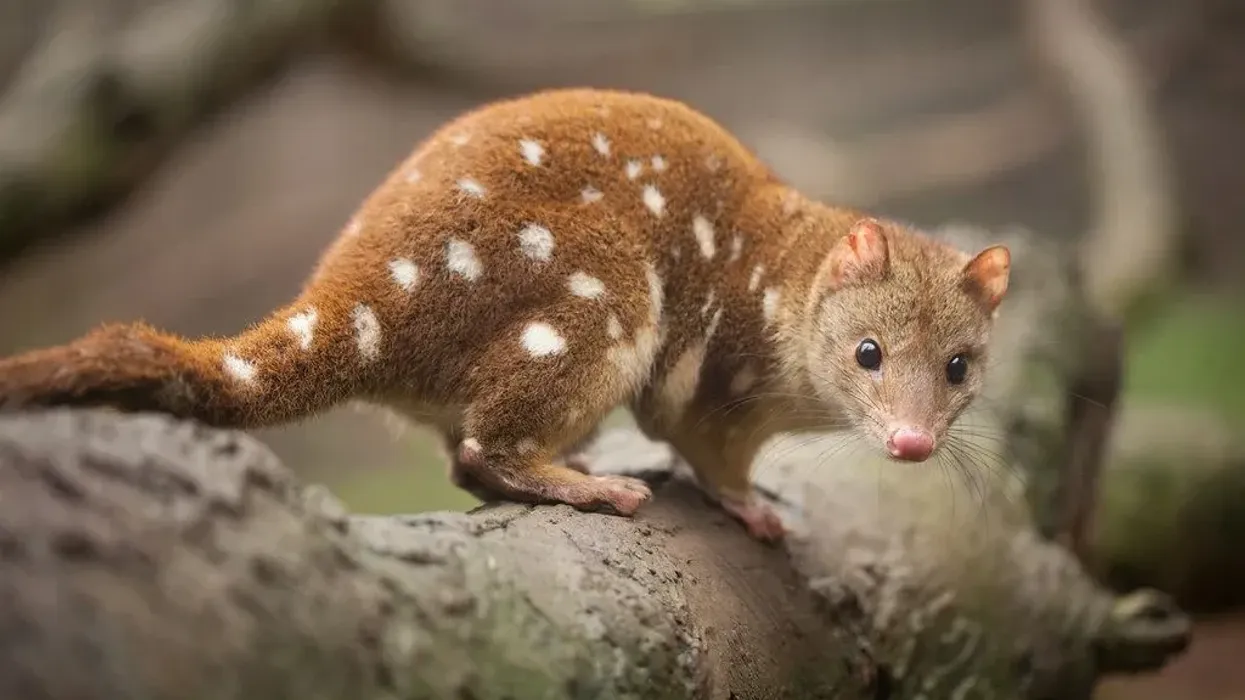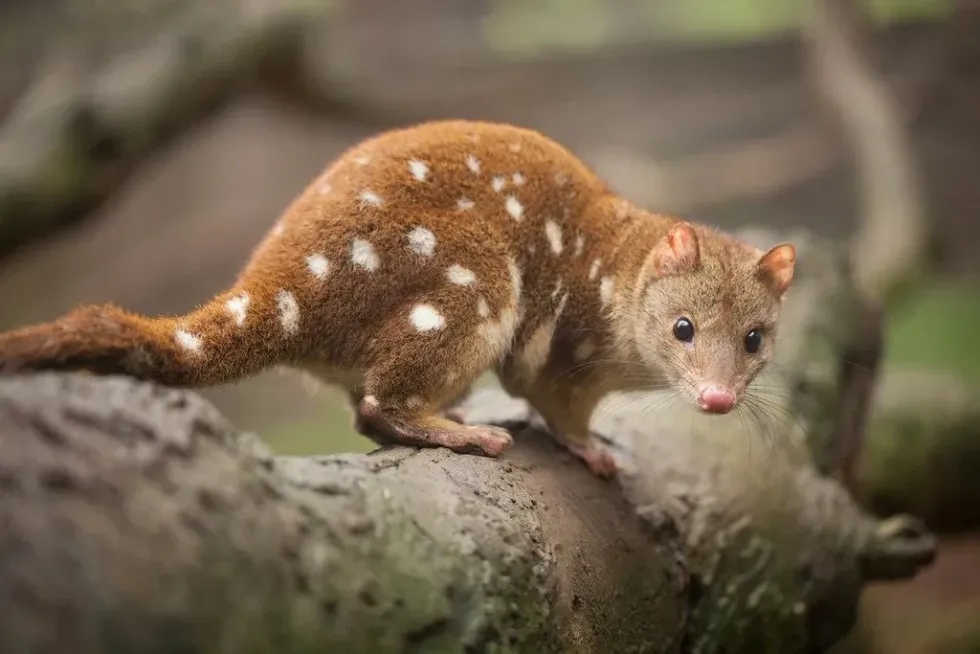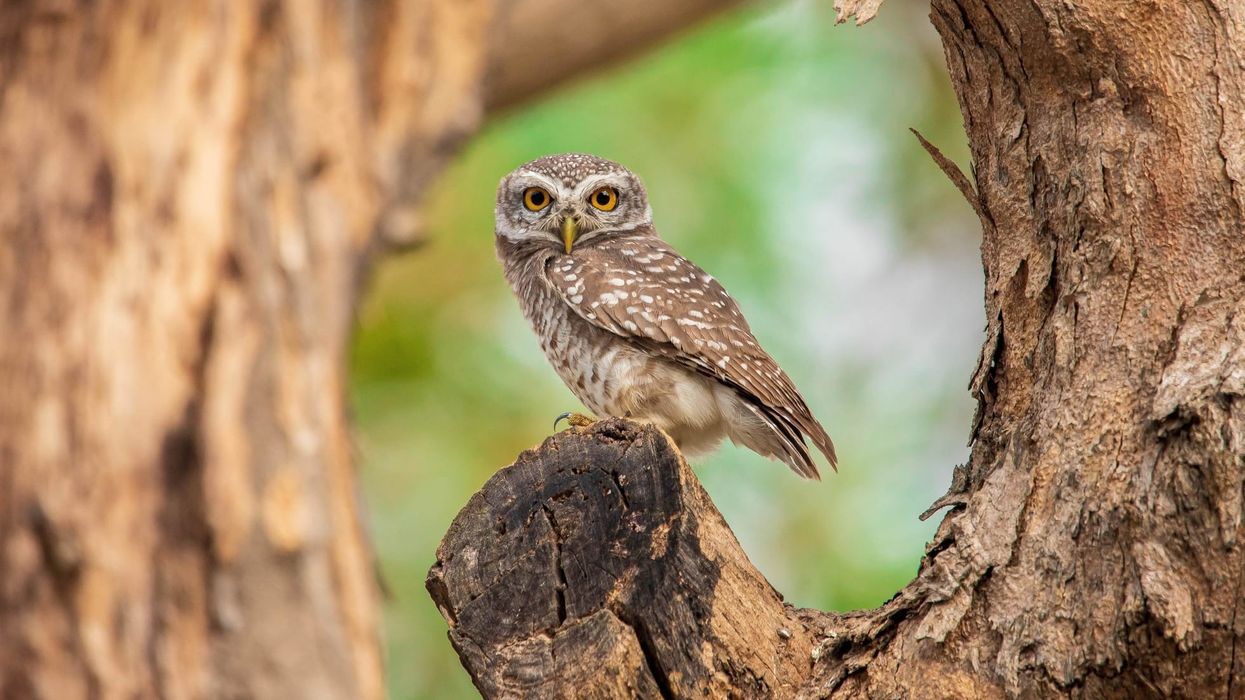Quolls, belonging to the genus Dasyurus, are a kind of marsupial (meaning that baby quolls stay in the mother's pouch after birth) that are native to Australia and New Guinea. This fascinating animal has six species, out of which four are found in Australia and two in New Guinea.
These six species of quolls are known as northern quoll, tiger quoll (or spotted-tailed quoll), eastern quoll, western quoll, bronze quoll, and New Guinean quoll.
Genetically it has been seen that quolls evolved 15 million years ago. The ancestors of the six species present today diverged nearly four million years ago.
Quolls are carnivorous marsupials with really sharp teeth and exceptionally long tails. They are medium-sized and generally brown, black, or fawn with white spots.
They also have bright pink noses and a prominent snout. Out of all the species of quolls, only the tiger quoll or spotted tail quoll has a true pouch. Even though they are normally seen on the ground, they can also climb trees in order to hunt.
Quolls had a pretty abundant population in their native lands, but their numbers have been on a constant decline for a while now. However, efforts are being made to revive the lost population.
A quoll is also sometimes referred to as a 'native cat' or 'tiger cat'. These animals tend to live in fallen logs, burrows, rock crevices, and even termite mounds.
Quolls are nocturnal, so they come out at night to hunt. They are also solitary in nature. To find out more about this amazing species of animals belonging to Australia and New Guinea, continue reading this compilation of interesting and fun quoll facts.
Quoll Interesting Facts
What type of animal is a quoll?
A quoll is a kind of marsupial present in Australia and New Guinea. There are six quoll species present, who all diverged from a common ancestor about four million years ago. Two other species of quolls have also been discovered from fossil remains that were found in Queensland.
What class of animal does a quoll belong to?
Quolls belong to the class Mammalia and are a part of the Dasyuridae family.
How many quolls are there in the world?
Though the exact number of quolls present is not known, their population has decreased drastically over the years. In Australia, all four species reduced in number since the country was colonized.
In the '60s, nearly 60 years ago, the eastern quoll population was completely wiped from mainland Australia. Currently, under the IUCN Red List, only the western quoll population is marked as stable.
The northern quoll, eastern quoll, spotted-tailed quoll, and New Guinean quoll all have decreasing trends in population. For the bronze quolls, population trends have been marked as unknown.
Where does a quoll live?
Quolls are native animals to Australia and New Guinea. Earlier, they could be seen throughout these regions, but their declining population has now restricted them to a few areas in eastern, south-eastern, and western Australia, and northern and southern New Guinea.
They are also part of some breeding programs, and hence, can be found in captivity as well. Interestingly, the tiger quoll is a quoll species with a large home range. They travel quite far and can travel distances of over 3.7 miles (6 km) in just one night.
What is a quoll's habitat?
Each species of quoll can be found in a different kind of habitat. The eastern quoll and tiger quoll, are found in the mesic habitat.
The western quoll can be found in mesic habitats too, but they have also adapted to arid habitats, where there is a lack of water, in inland Australia. For the northern quoll, a tropical habitat with sufficient warmth and rain is optimal.
In New Guinea, New Guinean quolls are mostly found in highlands and forest areas. The bronze species of quoll is commonly seen in grasslands and trans-fly savanna.
Who do quolls live with?
Quolls are a solitary species. They live alone in burrows, rocks, and tree logs. They only interact with others for particular social activities. During winter, male quolls come in contact with females for mating.
How long does a quoll live?
Quolls are only known to live for between two and five years. However, in captivity, it has been seen that their lifespan can be longer.
How do they reproduce?
The winter season is considered the breeding season for all species of quoll. The female quolls form their pouch during the breeding season itself. When the female has been impregnated by the male quoll, the fold which is present on her abdomen converts into a pouch.
Following a gestation period of 21 days, 18 baby quolls (or pups) are produced. Typically, only six survive in every litter. At one year of age, the baby quolls gain maturity.
What is their conservation status?
The four species of quoll which are native to Australia are the spotted tail quoll (also known as tiger quoll), western quoll, eastern quoll, and northern quoll. However, the eastern quoll (Dasyurus viverrinus) became extinct in mainland Australia in the '60s and is only found in Tasmania now, where one of their main threats is the Tasmanian devil.
The Dasyurus viverrinus, along with other species, started declining in Australia after colonization began.
Currently, the eastern quoll (Dasyurus viverrinus) and northern quoll (Dasyurus hallucatus) are listed as Endangered by the IUCN. The other two quoll species, spotted tail or tiger quoll (Dasyurus maculatus) and western quoll (Dasyurus geoffroii) are listed as Near Threatened.
In New Guinea, the New Guinean quoll (Dasyurus albopunctatus) and bronze quoll (Dasyurus spartacus) are found.
Both of these are listed as Near Threatened by the IUCN. Conservation efforts are underway to revive their population, and special efforts are being made to re-introduce the eastern quoll to mainland Australia.
Quoll Fun Facts
What do quolls look like?
Quolls are medium-sized marsupials with a fawn, brown, or black coat. They have tiny white spots scattered throughout their body. They also have very long snouts and a bright pink nose. Their tails are also quite long, hairy, and prominent, measuring anywhere between 7.9-13.8 in (20-35 cm).

How cute are they?
Quolls generally do look cute at a glance. Their pink noses and beautifully spotted bodies enhance their overall appearance.
How do they communicate?
Quolls only communicate through vocalizations. These vocalizations include barks, growls, hisses, chucks, and a "cp-cp" sound.
How big is a quoll?
Quolls have a length of 9.8-29.5 in (25-75 cm). Along with that, the tail is long and measures anywhere between 7.9-13.8 in (20-35 cm). They appear smaller in size when compared to a Tasmanian devil.
How fast can a quoll move?
Quolls are not considered to be very fast animals. When running in a straight line, a quoll can reach speeds of up to 15 miles per hour.
How much does a quoll weigh?
The average weight of quolls depends on their species. The tiger quoll is the largest, weighing 15.4 lb (7 kg).
The northern quoll weighs between 0.6-1.9 lb (0.3-0.9 kg). The western and eastern quolls have an average weight of 2.8 lb (1.3 kg). While the New Guinean quoll weighs 1 lb (0.45 kg), the bronze quoll weighs between 1.98-2.8 lb (0.9-1.3 kg).
What are their male and female names of the species?
The males are known as male quolls and the females are known as female quolls.
What would you call a baby quoll?
A baby quoll is called a pup.
What do they eat?
Quolls are carnivorous in nature. Smaller-sized quolls usually eat insects, birds, small snakes, and lizards. The bigger quolls eat birds, reptiles, and mammals (like possum) as part of their diet. Additionally, they are also known to kill and eat chicken in poultry farms and residential areas.
Are they dangerous?
Quolls have very sharp teeth and sharp claws, which they use for hunting. Hence, they can be considered dangerous if they are disturbed or agitated. However, the quolls which are bred in captivity tend to have a calm temperament and are also sociable.
Would they make a good pet?
Quolls that have been bred in captivity can be kept as companions for humans. However, as of now, native animals are not allowed to be kept as pets in all states in Australia. Though, researchers have suggested that domesticating these animals would result in an increase in their population. More research is required in this field.
Did you know...
Both quolls and Tasmanian devils belong to the same family of Dasyuirdae. It has also been seen that quolls tend to snatch from the Tasmanian devils, who are much larger in size. However, eastern quolls are themselves prey for Tasmanian devils.
Quolls can absorb all the water their body needs from the food they consume. Hence, they survive very well in drought seasons.
Their genus name Dasyurus was coined by Etienne Geoffroy Saint-Hilaire and the name means 'hairy tail'.
Quolls are nocturnal by nature and carry out most of their hunting and foraging activities at night.
Is the quoll endangered?
Out of the six species of quolls, the northern quoll and eastern quoll are listed as Endangered, while the other four species: western quoll, spotted-tailed quoll, New Guinean quoll, and bronze quolls are marked as Near Threatened.
The main causes behind their population declining are predators like foxes and big cats, highly toxic cane toads, poisonous pesticides, and habitat loss due to housing, mining, agriculture, and urbanization.
Attempts are being made to re-establish their steady population.
Different types of quoll
There are a total of six kinds of Dasyurus species quolls that exist today. Out of the six, four are indigenous to Australia, while two are native to New Guinea.
The western species of quoll is seen in the southwestern parts of Western Australia. They have a brown coat with white spots and a white underside.
Northern quolls are found in the Pilbara region in west Australia. The tiger quoll is also known as the spotted tail quoll and is the largest among all quolls. They are found in eastern parts of Australia.
Next, eastern quolls were initially abundant throughout southeast Australia, but now are only seen in Tasmania, after they became extinct in the Australian mainland. In New Guinea, the two quolls, the New Guinean quoll and bronze quoll, reside in the northern and southern regions, respectively.
Here at Kidadl, we have carefully created lots of interesting family-friendly animal facts for everyone to discover! You can even occupy yourself at home by drawing one on our quoll coloring pages.








